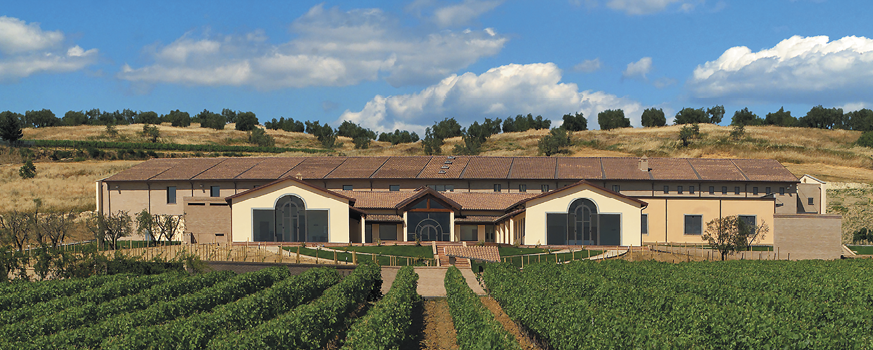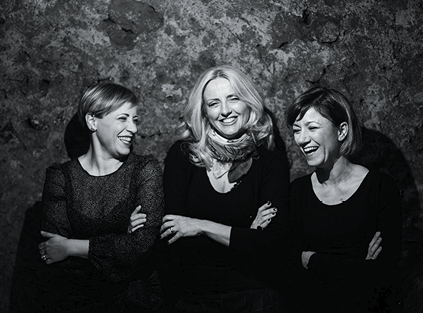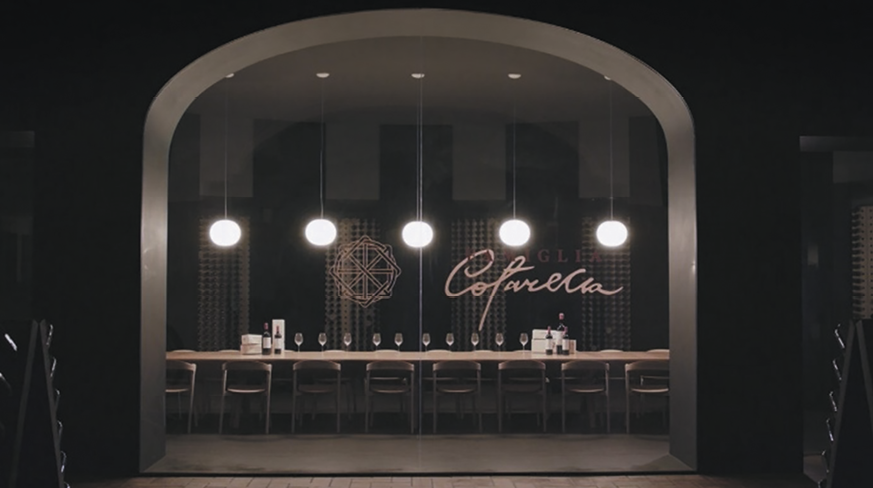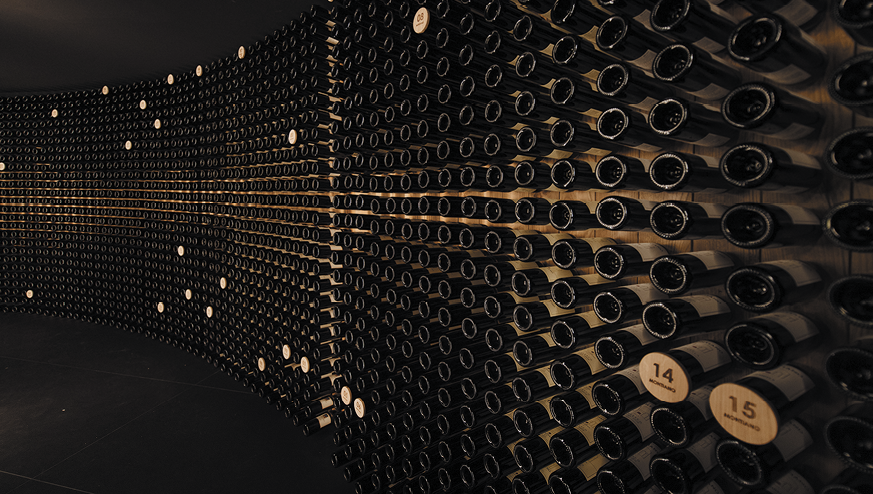- Home
- Media Kit
- MediaJet
- Current Issue
- Past Issues
- Ad Specs-Submission
- Reprints (PDF)
- Photo Specifications (PDF)
- Contact Us
- PRIVACY POLICY
- TERMS OF USE
![]()
ONLINE
![]()
ONLINE

A Family Business
Editors’ Note
Third generation Dominga Cotarella is the Chief Executive Officer of Famiglia Cotarella. She was born in Orvieto in 1974 to Riccardo and Maria Teresa Cotarella. She first became involved in her family’s wine business as a teenager and earned her degree in agronomy from the University of Tuscia (UNITUS). After graduation, she worked in Antinori’s marketing department for several years and then returned to Falesco in 2007 to lead the winery’s sales and marketing. In 2016, she and her cousins, Marta and Enrica, who she affectionately calls her “sisters,” officially took control of the family business and rebranded it as Famiglia Cotarella. In 2017, the three sisters created Intrecci – an advanced training school that educates its students on premium food and wine service, creating hospitality professionals that earn top positions worldwide post-graduation. The school collaborates with the Michelin Guide, and Forbes magazine named Dominga Cotarella as a top 15 Italian CEO in 2020 for her contributions to the innovation and expansion of her family’s companies while maintaining its deeply rooted traditions.
Winery Brief
Embracing three generations of winemaking, Famiglia Cotarella (famigliacotarella.it) presents a diverse range of wines, from white varietals native to Umbria and Lazio, to exceptional expressions of Merlot. Led by acclaimed Italian winemakers Riccardo and Renzo Cotarella, the Cotarella daughters, Dominga, Marta, and Enrica, continue to balance family tradition and innovation in each of their projects located throughout the Tuscia Region.

Famiglia Cotarella winery in the Tuscia Region of Italy
Will you discuss the history of Famiglia Cotarella?
Famiglia Cotarella’s history begins in 1920, when brothers Antonio and Domenico Cotarella grew grapes in Monterubiaglio, Umbria. In 1979, the second generation of the Cotarella family, my uncle, Renzo, and my father, Riccardo, founded Falesco, a wine company in Montefiascone, Lazio. They wished to recover old vine varieties in this area, successfully doing so over the course of the following decades. In 2016, Renzo’s daughters, Enrica and Marta, and I took over the family business and rebranded it from “Falesco” to “Famiglia Cotarella.” Since then, we have been working to prove the power of familial and feminine leadership, while also giving back to the community through education initiatives and wine marketing leadership.
Will you provide an overview of Famiglia Cotarella’s estate and wines?
In the Tuscia Region (spanning Tuscany, Umbria, Lazio), we have Cotarella’s flagship Umbrian estate, Montecchio, which produces Metodo Classico Brut Rosé Vino Spumante di Qualità, Trentanni Rosso Lazio IGP, Marciliano Rosso Umbria IGP, and RC2 Sagrantino di Montefalco DOCG.
Cotarella’s original production facility is in Montefiascone, Lazio, and produces Sodale Merlot Lazio IGP, Ferentano Bianco Lazio IGP, Sorélle Rosé Lazio IGP, Metodo Classico Brut Vino Spumante di Qualità, Soente Viognier Lazio IGP, Montiano Rosso Lazio IGP, Ogrà Rosso Lazio IGP, Pomele Aleatico Lazio IGP, Passirò Passito Bianco IGP, and Poggio dei Gelsi Est! Est!! Est!!! di Montefiascone DOP.
Cotarella’s newest Tuscan Estate, Montalcino, produces Brunello di Montalcino, Brunello di Montalcino DOCG, and Brunello di Montalcino Riserva.
A few additional details about Sodale Merlot Lazio IGP: In ancient Rome, “Sodale” meant “member of a partnership.” The same concept of fraternity is common to all generations of the Cotarella family, which is strongly linked to the Lazio region, where this wine is born. Known as Merlot experts, Sodale represents the Cotarella family’s dedication to Merlot from Lazio. The color is intense red with purple reflections. The smell comes with notes of red fruit and sweet spices that blend in a perfect balance with vanilla wood notes. The taste is round, harmonious, and pleasant, with good persistence and sweet tannins.
With our Ferentano Bianco Lazio IGP, the name Ferentano derives from the archaeological site of Ferento, an ancient Etruscan town located near the vineyards where the Roscetto grapes, which are used for the production of this wine, are grown. On the nose, it presents a rich range of olfactory sensations going from banana to pineapple, from vegetal to vanilla scents. The taste is assertive, rich, soft, and full with an excellent long lingering finish.

Dominga Cotarella with “sisters” Enrica and Marta
What have been the keys to Famiglia Cotarella’s growth and industry leadership?
The Cotarella family has been a leader in the Italian wine industry, realizing its strength in its second-generation winemakers, Riccardo and Renzo Cotarella, who each have extensive winemaking expertise and became well-known for recovering native regional varieties and experimenting with cuttings from France and Italy.
The third generation of the business – Enrica, Marta, and myself – came to the realization that the winery and the brand could become even stronger by emphasizing the deep and powerful bond we have with each other and with the territory, hence the decision to change the winery name from Falesco to Famiglia Cotarella, underlining the familial nature of the wineries in Central Italy.
As Cotarella “sisters,” we strive to understand the wine industry in its entirety, looking for ways to streamline efficiency in its distribution and understand wine market trends. In 2017, these desires prompted me to head the opening of a highly prestigious hospitality school named Intrecci, which allows us to engage the local community and to make a contribution to the on-premise side of the hospitality industry. I am also the President of Terranostra, the Italian agriturismo association promoted by Coldiretti, Italy’s main agricultural organization.
My focus on efficiency and community have reaped rewards, as I was named Forbes’ Italian CEO of the Year for Wine in 2020.

Famiglia Cotarella cellar
Will you highlight Famiglia Cotarella’s international expansion?
For international expansion, Famiglia Cotarella focuses on historical markets such as the U.S., Germany, and Japan, as these markets display a predisposed affinity for Italian wines. The U.S. is of particular interest for Famiglia Cotarella as it represents so many exciting opportunities for growth, although Germany’s competitive market and the Swiss’ love for up-scale wine also appeal to Cotarella. We recognize the importance of building strong professional relationships in these markets with importers and distributors, as people are the key to success in the wine industry.
For example, our mission to bring unknown varietals to new markets has been a success due to planning and interpersonal relationships. We look to present the wines to specialized accounts and to professionals who are looking for unique, indigenous varieties to share with their customers. We hope to expand our winery’s presence in on-trade accounts over the next few years through a combination of targeted tastings and market visits.

Famiglia Cotarella flagship estate cellar
What has made the working relationship between you and your two “sisters” work so well?
The Cotarella “sisters” have been by each other’s sides since we were young. In fact, our parents and uncles were always together, and therefore our cousins have always been “sisters.” Being so close as “sisters,” we are able to identify each other’s talents and support one another. For example, my previous leadership roles have helped me to learn how to be a strong leader and how to manage my team. Learning and growing the business is rewarding and that much more meaningful when done with one’s family.
Where did you develop your passion to foster growth and interest in winemaking and hospitality among the next generation?
Our family firmly believes that on-premise business is the reason Famiglia Cotarella is able to exist; each label in the winery can be tied to a restaurant opportunity. By creating Intrecci, we were aiming to fill a gap in the industry and to remedy it by educating committed professionals who are willing to work hard in a challenging environment. Students of Intrecci follow a 12-month preparation course. Six months are spent at a “mini-campus” where students attend theoretical lectures on hospitality, wine knowledge, client psychology, and basic restaurant management. The next six months are spent in a practical restaurant environment.
For Cotarella, this project pays off in dividends. Not only are we excited to contribute to young people’s growth and to foment a passion for hospitality among them, but we are also excited to see the lifelong relationships students create as a result of their time on campus.
Why do you think Intrecci has been such a successful project?
Intrecci has been so successful because there is high demand for qualified hospitality professionals. A resounding 100 percent of Intrecci’s students are employed within six months of program completion. In addition, school partnerships with the Michelin Guide, for example, have allowed the program to gain credibility. Graduates also become natural ambassadors for the program, as they are the ones on the front line displaying what an education at Intrecci means.
In the future, we hope to construct an on-site “mini-program” for restaurant workers who are already in the industry.![]()